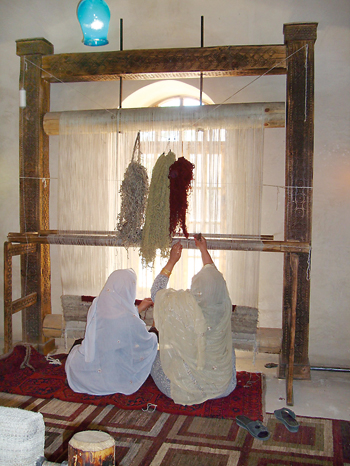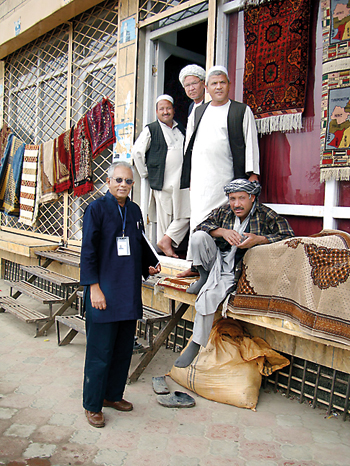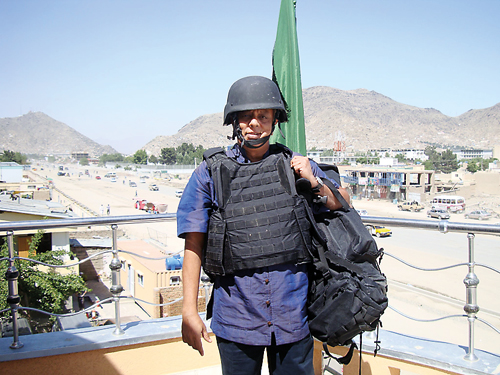Flak jacket, helmet at hand…

Weaving at home: Women at the loom
As the Taliban speedily took control of Afghanistan’s major cities last week, Tilak Samarawickrema was glued to the television. Memories of his time in that war ravaged land came flooding back as he watched the latest chapter in its troubled history unfold.
The veteran architect, artist and designer had been invited to Afghanistan in May-June 2010 on a USAID project to set up a design centre to help give young Afghan weavers an understanding of their heritage and a contemporary design aesthetic. Initially a little hesitant to accept the invitation given Afghanistan’s war situation even then, he now looks back on an enriching and unique experience.
Tilak Samarawickrema’s design expertise had seen him take the traditional weaves of the humble craftsmen of Thalagune, a village in the Kandyan foothills and invest them with such contemporary class that his tapestries were soon being exported and exhibited in major Western capitals and even at New York’s premier design store MOMA. He had also in 1990 spent time in Gautemala on a UNICEF backed project to train their indigenous weavers in modern design and so it was hardly surprising that when the International Executive Service Corps (IESC), Washington, was looking for a design consultant, they would pick him.

Weaving mission: Tilak with the carpet traders of Kabul
Whilst based in Kabul in a heavily fortified compound enclosed within high walls, Tilak was housed with other consultants and foreign experts, the only Asian among them. For security reasons, he was not allowed to venture out on his own to explore Kabul’s dusty streets and bustling bazaars. A flak jacket, helmet, and a backpack with first aid and other essentials were in his bedroom at night and had to be on hand, when he travelled, always accompanied by a military escort. Still for all these restrictions, it was a magical place, he remembers, Kabul – the city in a valley surrounded by hills with low rectangular houses whose windows glimmered with light at night. There were a few restaurants where they were allowed to dine at when they wanted a change from the canteen in the compound, these too with entrances sandbagged.
His mission though took him also to cities like Jalahabad and Mazar-i-Sharif, the latter the home of the spectacular Blue Mosque where Tilak snapped a rare shot of a woman selling embroidered children’s dresses. Though he met many progressive young women in Kabul, many of them having returned from abroad and looking to work in their own country, he is regretful to this day that he was not allowed to enter the homes of women carpet weavers in these cities. The intricate Afghan carpets are largely woven at traditional vertical looms by women. He was told that “their minds are like computers” easily retaining the complex designs in memory.

Tilak in full protective gear
So it was largely from the male weavers, the large-scale producers and the Afghan Carpet Guild from whom he gained an understanding of the carpet industry and his proposal was that the Design Centre should be set up at the University of Kabul. The plan was for a foundation course for young carpet weavers to gain a solid understanding of their roots and the rich heritage that coloured their designs while giving them an appreciation of contemporary design and markets, equipping them too with computer skills. The Americans were very sincere in their efforts to support this industry, he says, citing the investments they had made in cities like Jalalabad with modern machines to clean and make ready the rough carpets that the rural weavers would bring in, for sale.
He had even sourced the lecturers from among the Faculty of Fine Arts at Kabul University so that the course could be taken forward by the Afghans themselves. But it was not to be as the ground situation worsened soon after and with the Americans suffering heavy casualties, the project was not realised.
Watching the Americans leave and the Taliban seize control, his thoughts were with the warm, friendly Afghan people with whom his work apart, cricket was a shared bond. His hope is that the Taliban could be more moderate, this time – after all, this is a different generation, he says.


